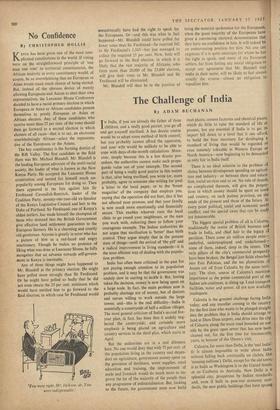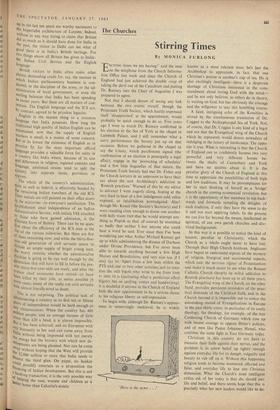The Challenge of India
By ADAM BUCHANAN T N India, if you are already the father of three children, and a really good patriot, you go off and get yourself sterilised. A less drastic course would be to adopt some method of birth control; but you probably cannot afford the apparatus, and your wife would be unlikely to be able to cope with days-of-the-month calculations. More- over, simply because this is a less drastic pro- cedure, the authorities cannot make such propa- ganda value out of your example. The second part of being a really good patriot in this matter is that, after being sterilised, you write (or, more probably, agree to someone else writing for you) a letter to the local paper, or to the 'house magazine' of the company that employs you, saying that the operation did not hurt, that it has not affected your prowess, and that your family is now much more emotionally and financially secure. This enables whoever runs the local clinic to go round your neighbours, or the men you work with, exhorting them to follow your courageous example. The Indian authorities do not argue that sterilisation is 'better' than birth control. They argue simply that in the present state of things—until the arrival of 'the pill' and a radical improvement in living standards—it is the most efficient way of dealing with the popula- tion problem.
India has often been criticised in the past for not paying enough attention to its population problem, and it may be that the government was unduly slow in starting to tackle it. But, having taken the decision, money is now being spent on a large scale. In fact, the main problem now is probably shortage not of money, but of doctors and nurses willing to work outside the large towns; and—this is the real difficulty—India is essentially a countryside of half a million villages. The most general criticism of India's second five- year plan, in fact, has been that it unduly neg- lected the countryside; and certainly more emphasis is being placed on agriculture and country services in the third plan, which starts in April.
But the authorities are in a real dilemma here. No one would deny that with 75 per cent. of the population living in the country and depen- dent on agriculture, government money spent on the provision of fertilisers, water supplies, rural education and training, the improvement of seeds and livestock would do much more to im- prove the lot of the majority of the people than any programme of industrialisation. But, looking to the future, the government must now build steel plants, cement factories and chemical plants, which do little to raise the standard of life at present, but are essential if India is to get, its import bill down to a level that it can afford, to build the base necessary for developing a standard of living that would be regarded as even remotely tolerable in Western Europe or North America—now beginning to be demanded as only fair in India itself.
There is no ideal solution to the problem of choice between development spending on agricul- ture and industry--or between these and educa- tion, social services and so on. No rule of thumb, no complicated theorem, will give the propor- tions in which money should be spent on town and country, on each jealous province, on the needs of the present and those of the future. At every point political, social and economic needs conflict; and the special cases that can be made are innumerable.
The biggest special problem of all is Calcutta, traditionally the centre of British business and trade in India, and chief heir to the legacy of partition. There some six million people exist— underfed, underemployed and underhoused- some of them, indeed, sleep in the streets. The twin pillars of the city's commercial prosperity have been broken; the Bengal jute fields absorbed into East Pakistan, and the tea plantations of Assam cut off from Calcutta by the same terri- tory. The river, source of Calcutta's maritime importance as the prime commercial port of the Indian sub-continent, is silting up. Land transport facilities, water and power, all are now woefully inadequate.
Calcutta is the greatest challenge facing India today; and any traveller coming to the country for the first time who wants to be plunged straight into the problem that is India should arrange to land at Dum Dum airport, and drive into the city of Calcutta along the main road bounded on one side by the great open sewer that has now been cleaned out, for the first time for innumerable, years, in honour of the Queen's visit.
Calcutta, far more than Delhi, is the 'real India' (ft is almost impossible to write about India without falling back continually on clich5s, like 'teeming millions'). Delhi, except for the old town, is to India as Washington is to the United States, or as Canberra to Australia. New Delhi is 3 splendid city, prosperous by Indian standards, and, even if built to post-war economy stan- dards, the new public buildings that have sprung UP in the last ten years are worthy successors to the Imperialist architecture of Lutyens. Indeed, without in any way trying to claim that Britain did as much as it should have done for India in the past, the visitor to Delhi can see what of good there is in India's British heritage. For two things above all Britain has given to India: the Indian Civil Service and the English language.
British visitors to India often make other claims, demanding credit for, say, the manner in Which Indian parliamentary business is con- ducted, or the discipline of the army, or the ad- ministration of local government, or even the sterling balances that India has been spending in recent years. But these are all matters of con- tention. The English language and the ICS arc, 1:11' contrast, agreed to be priceless legacies. English is the nearest thing to a common language that India possesses. How long the traditional high quality of Indian English can be maintained, now that the supply of English teachers is small, is a matter of some concern. But at its lowest the existence of English as in practice by far the most important official language provides a valuable force for unity in a country like India where, because of its size and differences in religion, regional customs and language, continual. strains tend to split the Country into separate states, provinces or regions.
The whole of the country's administration, Slate as well as federal, is effectively headed by the remaining Indian members of the old ICS. 1 heir initials are still painted on their office doors in the ministries—to everyone's satisfaction. The establishment since independence of an Indian Administrative Service, with initials IAS attached to those who have gained admission, is the Ilitcerest form of flattery. There can be no ques- t on about the efficiency of the ICS men at the 1°P of the various ministries. But there are few them remaining now; and while the thirty-five- Year-old generation of civil servants seems to in, elude an ample supply of bright young men, the worry remains whether the administrative machine is going to be run well enough by the gtneration that will have to fill in before the pre- stlt thirty-five-year-olds are ready, and after the Present chief secretaries have retired—or have been killed by their jobs, as seems possible in "'rile cases; many of the really top civil servants took almost literally-tired to death.
This is not surprising. The political task of administering a country in its first ten or fifteen Years of independence would be hard enough .in any circumstances. When the country has 400 million people, and an average income of little more than £20 a head, it is almost impossible. But it has been achieved, and no European with 4 nY humanity in her soul can come away from India without being impressed with not merely the energy but the bravery with which new de- velopments are being planned. Nor can he come away without hoping that the West will provide :e £2,000 million or more that India needs to "'lance the third plan. On paper, no banker !Mild possibly entertain as a proposition the _ilnancing of Indian development. But this is not aanking transaction; it is the only possible way ° Lt helping' the men, women and children to a tier home than Calcutta's streets.











































 Previous page
Previous page